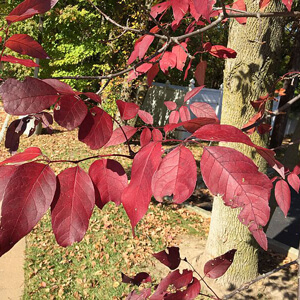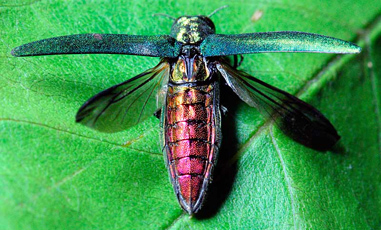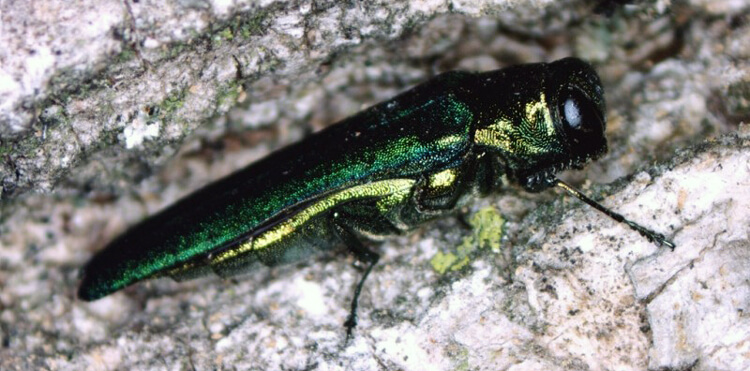Emerald ash borer (Agrilus planipennis) is an exotic, invasive wood-boring beetle native to eastern Asia. It is believed to have been introduced to North America in the 1990’s through wood packing material imported from Asia. The insect was officially discovered in southeastern Michigan near Detroit in June 2002. Emerald ash borer has since become widespread throughout the United States and Canada, and is responsible for decimating large ash tree populations, with tens of millions of ash trees confirmed to have been affected.
Hosts

Emerald ash borer feeds primarily on ash trees, including green, white, black, and blue ash. Infestations have also been reported in white fringetree. Emerald ash borer reproduces in trees of all sizes: from saplings to fully mature trees.
Appearance
Emerald ash borer is a small jewel beetle with a brightly colored body. Adults range from one third to just over half an inch in length. Females tend to be larger than males. Each beetle has a red upper abdomen that is comprised of multiple segments, and a small spine that is located at the tip. Dark green forewings conceal much of the insect’s body. Each forewing has a distinct metallic sheen, which differentiates the emerald ash borer from other wood boring beetles. On some occasions, forewings may also display tinges of copper. A pair of small, serrate antennae protrude outwards from its head, curling downwards over a set of bulbous eyes. In rare instances, coloration may be inverted, with adults developing a blue or red exterior, and a brassy-green abdomen.
Emerald ash borer eggs are exceedingly tiny, measuring 0.02 to 0.04 inches in diameter. They are white in their initial stages, but later turn an amber shade as they develop. Upon hatching, larvae are white, with a slightly flattened body that consists of multiple segments. Each larvae has a brown pincer-like appendage that is attached to the final abdominal segment.
Life Cycle
Following mating, adult females flock to trees, and deposit up to two hundred eggs between bark crevices, flakes, or wounds. They generally target injury stressed trees, but they may also lay their eggs on healthy trees. Eggs hatch within fifteen days, revealing scores of larvae. Larvae then chew their way through the bark, tunneling into the tree’s inner phloem and cambial layers. They reside here, feasting on woody tissue. During this period, they develop through four instars. In late summer and early fall, larvae excavate a chamber where they fold into a j-shape and shorten into prepupae. They continue to develop through the winter months, maturing into adults.
Adults emerge the following spring, tunneling their way out from their chambers. As they depart the tree, they leave a d-shaped exit hole. After emerging, adults feed on ash leaves for a week. Shortly thereafter, males begin scouring nearby trees for females. Once they have selected a partner, the adults mate, and the cycle begins anew. Adult emerald ash borers live for three to six weeks. They spend this period alternating between feeding and mating. Females that live longer tend to produce more eggs.
Impact on Trees
As larvae feed on the inner bark of trees, they produce serpentine feeding galleries that disrupt the tree’s conductive system. This impedes the tree’s ability to transport and distribute water and nutrients, resulting in foliar dieback and declining tree health. The severity of the injury tends to culminate in the death of the tree within three to five years.
Detection & Management
A visual survey should be conducted by a professional arborist to determine if trees are displaying symptoms of emerald ash borer. If emerald ash borer is discovered to be present, there are a number of traps that can be used to contend with adults. One type of trap is made up of colors that are attractive to emerald ash borer. These can be hung in trees in an effort to monitor emerald ash borer behavior. Other traps can have volatile pheremones applied to them in order to lure out adults. These are most effective with males.
Trees can be girdled and used to trap egg laying females in spring. Once eggs have been deposited into the bark, the tree is then debarked in fall so that the larvae may be detected. If larvae is discovered, the area can be placed under quarantine in order to prevent further infestation. Although complete extermination is not often viable, additional control methods can then be taken to reduce the larval population, and hinder their dispersal. Infected trees are often removed and replaced with non-ash species to deter population growth.
In North America, government agencies within the United States and Canada have utilized a large ground-nesting wasp called cerceris fumipennisto to detect emerald ash borer in trees. The wasps do not impact the emerald ash borer populations, but they enable arborists to more effectively determine their presence. This process is referred to as biological surveillance.
Systemic insecticides can be incorporated into the tree through direct injection or soil drenching. These remain effective for one to three years depending on the product, but if applied over a period of years, tree injections can compromise the tree’s health. If a tree is already infested, insecticides may deter further population growth, but they will not prevent emerald ash borer from causing additional internal damage. Insecticides are not feasible for large areas experiencing widespread infestation.
Additional Resources
Photo credit: USDAgov via Foter.com / CC BY-ND
Famartin – Own work, CC BY-SA 4.0



